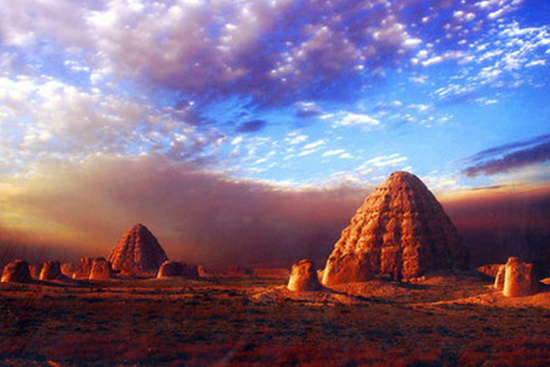
Imperial Mausoleum of Western Xia
Western Xia is a Chinese feudal dynasty established by Dangxiang people, a branch of Qiang people in the early of the 11th century. In 1038, Li Yuanhao, the founder of Western Xia, proclaimed emperor in Xingqing (today’s Yinchuan) and Western Xia coexisted with Northern Song Dynasty, Liao, Southern Song Dynasty and Jin successively and lasted for189 years and was ruled by 10 generations of emperors in Chinese history. In 1227, Western Xia was defeated by Mongolia. Imperial Mausoleum of Western Xia is royal mausoleums of Western Xia Dynasty, which covers an area of 58 square kilometers. In the cemetery, there are 9 well-arranged mausoleums for emperors and 255 subordinate tombs scattered. It is a huge cemetery park and one of the largest existing and best preserved imperial mausoleums in China. Tourists may visit the Western Xia mausoleums site, the subordinate tombs site, the Western Xia Museum, the Western Xia Historical Museum and the Western Xia Inscriptions etc.. Here you can explore the historical traces of Western Xia Dynasty and get to know and feel mysterious Western Xia culture.
There are 9 mausoleums for emperors in the site. According to the numbers assigned in 1990, No. 1, 2, 3, 5, 7 and 9 stand in plain area while No. 4, 6 and 8 are built alongside mountains. Facing south, each mausoleum is an oblong and covers an area of over 100,000 square meters. These mausoleums are different in outlines and shapes such as open type, enclosed type and those without outer parts, but similar in internal structure, divided into such four parts as frustum, stone memorial arch, Yuecheng and Lingcheng. The proportion of the outer parts between length and width is 1.5:1.7, the same as that of Xingqing in historical records. There are historical records of only 9 mausoleums, but none of mausoleums of Emperor Shenzong Li Zunxu, Emperor Xianzong Li Dewang and the last emperor Li Xian. These three mausoleums for emperors which might exist perhaps were not built due to the turmoil of war, or they might be razed by some local construction unit in the 1960s. In the four regions between these mausoleums, there stand at least 254 subordinate tombs. In the surrounding areas of No. 7, 8 and 9, archaeologists discovered the ruin of an ancestral temple of Western Xia Dynasty.
There are 16 sites of existing stone-tablet pavilions surrounding the 9 mausoleums, No. 1 and 2 with 3 pavilions, No. 3 with 2, No. 4 with 1 west stone-tablet pavilion, No. 5 with 3, No. 6 with 2 and No. 7 with 2. All the buildings around No. 8 and No. 9 were razed except towers, so there is no stone-tablet pavilion. According to the building regulations and layout of other mausoleums, it is estimated that there are at least 2 stone-tablet pavilions surrounding No. 8 and 9 respectively. In the 1970s, 4 statue bases were discovered in the west stone-tablet pavilion of No. 9.
There is a large-scale mausoleum-like construction site north by east covering 100,000 square meters, where stand clearly visible squares, roads, yards, wells and houses with standard and tidy layout. Around the site are city walls made of tamped earth. Inside the city, there are three parts, the front, the middle and the back. The center of the middle and the back lie respectively a magnificent palace, while other buildings collect in the front and the middle, forming different enclosed courtyards. A large number of colorful cultural relics were excavated from the ruins, including green glazed pan tiles, arched tiles, eaves tiles, drip tiles, ridge tiles, roof ridge ornaments and other architectural elements, such as ivory or bluish white porcelain pan tile with cracked ice patterns, tile with black glaze on the side and exquisitely carved stone.
Near the mausoleum area, on the west bank of Xigan Channel, Wuwang Channel and hills on the its side, there distributes dozens of kiln sites of Western Xia Dynasty from north to south, stretching as far as seven to eight kilometers. Among all the sites, there are tile kilns and lime kilns that produced building materials such as twin bricks, oblong bricks, stripe bricks, pan tiles, arched tiles, eaves tiles, drip tiles and glazed ornaments. According to researchers’ speculation, the kiln site was set up to produce building materials for the imperial tombs of Western Xia.
|
 将本信息发给好友
将本信息发给好友  打印本页
打印本页